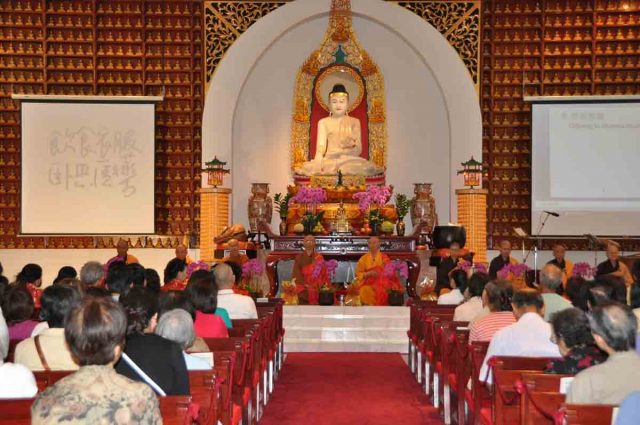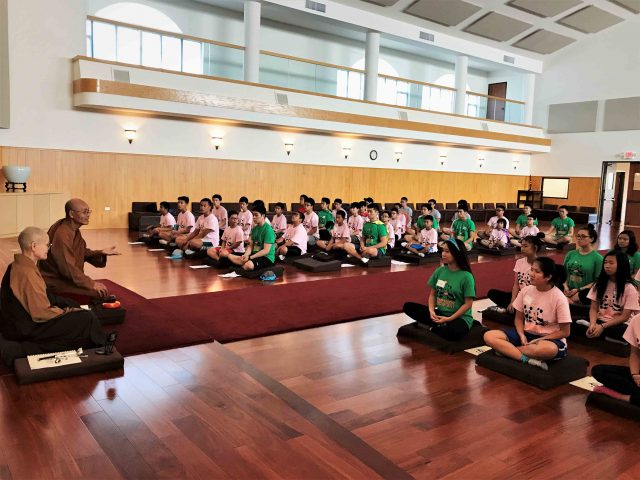City: Houston, Texas
Tradition: Nondenominational
Year Founded: 1979
Number of Members: An estimated 1,500 families
Meeting Place: Jade Buddha Temple (Houston) and American Bodhi Center (Hempstead)
Tricycle speaks with Texas Buddhist Association’s English Dharma Group coordinator, Barbara Homann, and senior sangha member Josten Ma.
How was the Texas Buddhist Association sangha affected by Hurricane Harvey?
Barbara Homann (BH): We had about 30 families that were impacted. I know from our English Dharma Group [the sangha’s English language-based program] alone on the west side of town there were four members’ homes that were flooded.
Was the temple itself affected?
BH: There was water in some streets around the temple, but the temple was not flooded. Families or individuals who were flooded were allowed to stay in the temple’s smaller rooms. During that first week we started a temporary childcare center for the families who had no electricity or had to take care of the first steps to get their lives and houses in order, all at no charge. For those families who came forward with demonstrated need, the temple gave monetary support and the Venerables gave emotional support.
More than ever, the sangha is a precious jewel during these challenging times. That’s what I personally felt from what I saw throughout the city. And it’s beyond religion, beyond faith. A community helps each other. The sangha is there to help, be it to just check in with you or to help with money or with manpower. This concept of compassion was there throughout the city of Houston. Truthfully, the crisis brought out the humanity in every one of us.

How was TBA founded, and when did the English Dharma Group emerge?
Josten Ma (JM): Ven. Jan Hai was the first monk who came to Texas from New York, and East Asia before that, more than 35 years ago. And at that time if you asked people what Buddhism was they just said, “What?” [Laughs.]
TBA started in a house they called Buddha Light outside of Houston. Slowly we acquired a two-and-a-half-acre property inside Houston close to the Chinatown area, and that’s where Jade Buddha Temple was built [in 1990]. At that time most of TBA’s membership was a Chinese, Mandarin-speaking population, but there were a few English visitors who made requests for teachings to Ven. Hung I [Jade Buddha Temple’s current abbot] and a year later the English Dharma Group started.
BH: Today, we have two facilities, the American Bodhi Center, which is a 515- acre retreat center in Hempstead, Texas, an hour north of Houston, and Jade Buddha Temple. And with these two together, we are one of the largest Buddhist facilities in the country, at least by area.

What tradition of Buddhism is TBA a part of?
JM: That’s a very good question. [Laughs.] TBA is quite unique in the sense that the two monks that lead the group are very, very open-minded. Both are trained in Mahayana. Venerable Jan Hai, who is the original founder, actually trained in Sri Lanka and is well-versed in Pali in addition to Chinese. He and Venerable Hung I also trained in a Mahayana school in Taiwan. Even though we started this way, we have had many monks, nuns, and teachers from different schools. That’s why I laughed when you asked the question, because I don’t know—Mahayana, Theravada, we are everything.
BH: We get this question a lot, especially from those who visit our temple for the first time or who come from colleges or high schools. Their first question is always, “What school of Buddhism do you belong to?” I was always given the answer, “We do not distinguish between different schools as long as we are teaching the Buddha’s teaching of lovingkindness and compassion.”
What does TBA offer for programs?
BH: The Chinese sangha meets every Sunday in our grand hall for a chanting service and a dharma talk. Part of the Chinese service is also a choir—the Bodhi Choir. We also have a youth group for children ages 11–18 who meet twice a month for dharma discussions, and the youth activity center, the Bodhi Chinese School, offers weekend classes for children to learn Chinese language and do cultural activities such as calligraphy or yoga. A violin class meets there on Sundays as well.
As for the English Dharma Group, every Sunday morning we have between 25 and over 40 people attending a dharma talk and meditation. At TBA we have five resident monks and four resident nuns. Ven. Katapunno, the resident monk at the American Bodhi Center, is one of our English Dharma Group’s regular speakers and meditation leaders. Along with him, the meditations are led by lay people.
JM: The Chinese service is about the same size, sometimes a little bit more, with 25 to 50 people. Then there are four occasions throughout the year—like the Buddha’s birthday—when the hall is packed and there’s standing-room only.

Does the English Dharma Group’s Sunday service differ from that of the Chinese sangha? Do they overlap?
JM: The Chinese service is slightly different in the sense that the Chinese group tends to like chanting types of meditation. The English Dharma Group focuses mainly on vipassana or shamatha, and once in awhile we have lovingkindness meditation.
BH: Josten mentioned the four Sundays throughout the year where we come together as one for both Buddhist holidays and Chinese celebrations. One of them is the Chinese mid-autumn celebration, which is kind of a Chinese version of Thanksgiving. For that service, the Chinese community will ask a representative from the English Dharma Group to speak on their experience at the temple and in walking the path of the Buddha. In this way, we become involved with the temple’s Chinese community.